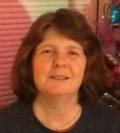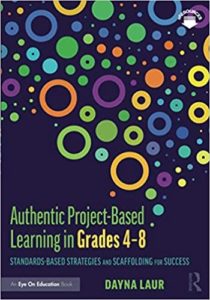Authentic Project-Based Learning in Grades 4-8
Authentic Project-Based Learning in Grades 4-8: Standards-Based Strategies and Scaffolding for Success
By Dayna Laur
(Routledge/Eye On Education, 2020 – Learn more)

“. . . (C)reating a classroom ecosystem in which all learners are challenged to create, rather than remember, information that one can quickly look up on their smartphone, develops learners who are far better prepared to participate in the world outside of school.” (p. 129)
I don’t know about you, but this is the way that I want to teach, to help students be as prepared as possible for success in the world after school. They are, after all, the ones who will solve the problems we will face and provide our hope for our future world.
Getting specific about implementing PBL

Also unlike other books on the topic, Laur gives us a 5-stage process using the lens of formative assessment, with embedded technology, literacy and the so-called 21st Century skills.
Throughout the book Laur emphasizes the need to be at Bloom’s level of authentic creation. She thus starts the book in chapter one with the creation of an authentic project that is complex rather than complicated, and that is relevant with an authentic audience, preferably in the local community.
Laur’s five stages of PBL are
1) Challenge and Purpose, which deals with laying out the challenge (project), its purpose and getting students to buy in;
2) Inquiry and Ideas, where students brainstorm ways to solve the problem inherent in the challenge and begin researching multiple pathways to an outcome;
3) Context and Perspective, where students use reflection and expert feedback to determine which pathway they believe will be best to meet the end-users’ needs;
4) Actions and Consequences, as students consider if their solutions were put into action what would be the positive and negative consequences of such action; and
5) Options and Opportunities, which includes the final product, which may also include presentation to an authentic audience with a goal of persuasion to put the solution into action.
Centering the classroom around PBL
In chapter two Laur then goes on to discuss pacing and teaching the content standards through authentic projects, not as a “once in a while” activity, but as the main way to teach all the standards. Next, cross-curricular planning is discussed as is the inclusion of digital transformation with the ISTE (International Society for Technology in Education) standards (chapter three) and literacy standards (chapter four).
While chapter five specifically addresses formative assessment, as stated above the entire book is written from the formative assessment perspective. In each chapter, as each of the five stages are discussed in relationship to that topic, formative assessment is the key to determining success, readiness, and scaffolding needs for each stage.
Suggested strategies that can be used, and which are cataloged in the appendix, are included with each stage as part of a full description of one specific way to carry out this type of PBL. Specific project examples are also given throughout the book.
Chapter six focuses on complexity levels throughout the project and discusses individual, team and whole class options to assure that all students are engaged in all parts of the learning process, as well as that the products also have the possibility of being implemented.
Chapter seven rounds out the focus on implementation of the five stage PBL process with a clear description of embedding and assessing the 4 C’s of 21st Century learning: critical thinking, collaboration, communication and creativity (coming back full circle as this is the Bloom’s level that is used for the beginning of the challenges). The final chapter is a thorough FAQ section, and the 3 appendices provide great resources for implementation.
If you are considering implementing PBL, you will find that this book provides a solid framework and a detailed presentation of steps and procedures, along with examples and many formative assessment tools to help you determine next steps and needed supports that are specific for middle grades learners.
Dr. Laura Von Staden is currently a middle school Gifted Math and Science teacher in Tampa, Florida. She serves on numerous committees in her school district, works closely with the local university, and writes curriculum. She is also a professional development consultant, and previously served as an Exceptional Student Education Specialist and as a mentor.



































